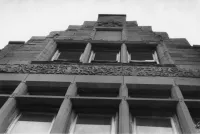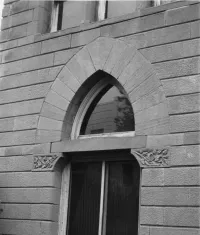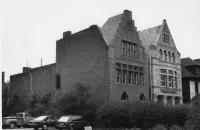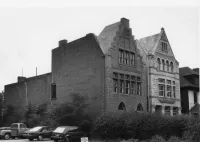Share what you know,
and discover more.
Share what you know,
and discover more.
Aug 18, 1983
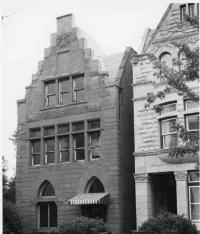
-

- Charmaine Bantugan
National Register of Historic Places - William Lang Townhouse
Statement of Significant: The William Lang Townhouse, constructed in 1890, has architectural distinction in Denver through its quality and uniqueness of design, use of materials and state of preservation. It also has historical importance in serving as the private residence of William Lang, "the most popular and prolific designer of domestic architecture in nineteenth century Denver." Lang began his career in Denver in 1886 and did the vast majority of his building between 1888 and 1892. "His houses ranged from cottages to mansions and were contrustructed in every part of Denver and in most of the city's nineteenth century suburbs."2 He was considered Denver's most eclectic architect of the day. "He never built a building in a clear nameable style and was an architect who conceived of a building as a combination of architectural elements derived from a great many other buildings." His was an architecture of flamboyant complexity in direct opposition to the simplicity of the Richardsonian style popular at that time. His work has been termed "an architecture of the melting pot." "It was an egalitarian and unbiased architecture free from the imperialist imagery of the Second Empire. Its esthetic was one of complexity, confusion, and, as Robert Venturi would no doubt add, contradiction. Its enemy was classicism, rationality, and clarity. " The William Lang Townhouse was constructed in 1890 and Lang lived there until his career came to an abrupt end with the great silver crash of 1893. There are no records of William Lang in Denver beyond 1893. The townhouse, a remarkable structure in itself, is part of an original group of five townhouses which as a whole is perhaps the best example of Lang's fantastic eclecticism. Notable in the design of Lang's residence is the use of stone facing on the primary facade, the front stepped gable, a richly carved panel between the second and third floors, and the arched bays on the first floor. The house is significant under Criterion B for its association with Samuel E. Kohn, who built the house and lived here with his family until his death in 1943. Kohn was a prominent merchant who founded American Furniture Company and built it from a small business to a leading retail firm. He was also influential in professional, civic, and religious affairs, holding leadership positions with National Jewish Hospital, Temple Emanuel, Green Gables Country Club, the Better Business Bureau, and the National Retail Furniture Association.
National Register of Historic Places - William Lang Townhouse
Statement of Significant: The William Lang Townhouse, constructed in 1890, has architectural distinction in Denver through its quality and uniqueness of design, use of materials and state of preservation. It also has historical importance in serving as the private residence of William Lang, "the most popular and prolific designer of domestic architecture in nineteenth century Denver." Lang began his career in Denver in 1886 and did the vast majority of his building between 1888 and 1892. "His houses ranged from cottages to mansions and were contrustructed in every part of Denver and in most of the city's nineteenth century suburbs."2 He was considered Denver's most eclectic architect of the day. "He never built a building in a clear nameable style and was an architect who conceived of a building as a combination of architectural elements derived from a great many other buildings." His was an architecture of flamboyant complexity in direct opposition to the simplicity of the Richardsonian style popular at that time. His work has been termed "an architecture of the melting pot." "It was an egalitarian and unbiased architecture free from the imperialist imagery of the Second Empire. Its esthetic was one of complexity, confusion, and, as Robert Venturi would no doubt add, contradiction. Its enemy was classicism, rationality, and clarity. " The William Lang Townhouse was constructed in 1890 and Lang lived there until his career came to an abrupt end with the great silver crash of 1893. There are no records of William Lang in Denver beyond 1893. The townhouse, a remarkable structure in itself, is part of an original group of five townhouses which as a whole is perhaps the best example of Lang's fantastic eclecticism. Notable in the design of Lang's residence is the use of stone facing on the primary facade, the front stepped gable, a richly carved panel between the second and third floors, and the arched bays on the first floor. The house is significant under Criterion B for its association with Samuel E. Kohn, who built the house and lived here with his family until his death in 1943. Kohn was a prominent merchant who founded American Furniture Company and built it from a small business to a leading retail firm. He was also influential in professional, civic, and religious affairs, holding leadership positions with National Jewish Hospital, Temple Emanuel, Green Gables Country Club, the Better Business Bureau, and the National Retail Furniture Association.
Aug 18, 1983
National Register of Historic Places - William Lang Townhouse
Statement of Significant:The William Lang Townhouse, constructed in 1890, has architectural distinction in Denver through its quality and uniqueness of design, use of materials and state of preservation. It also has historical importance in serving as the private residence of William Lang, "the most popular and prolific designer of domestic architecture in nineteenth century Denver."
Lang began his career in Denver in 1886 and did the vast majority of his building between 1888 and 1892. "His houses ranged from cottages to mansions and were contrustructed in every part of Denver and in most of the city's nineteenth century suburbs."2 He was considered Denver's most eclectic architect of the day. "He never built a building in a clear nameable style and was an architect who conceived of a building as a combination of architectural elements derived from a great many other buildings." His was an architecture of flamboyant complexity in direct opposition to the simplicity of the Richardsonian style popular at that time. His work has been termed "an architecture of the melting pot." "It was an egalitarian and unbiased architecture free from the imperialist imagery of the Second Empire. Its esthetic was one of complexity, confusion, and, as Robert Venturi would no doubt add, contradiction. Its enemy was classicism, rationality, and clarity. "
The William Lang Townhouse was constructed in 1890 and Lang lived there until his career came to an abrupt end with the great silver crash of 1893. There are no records of William Lang in Denver beyond 1893. The townhouse, a remarkable structure in itself, is part of an original group of five townhouses which as a whole is perhaps the best example of Lang's fantastic eclecticism.
Notable in the design of Lang's residence is the use of stone facing on the primary facade, the front stepped gable, a richly carved panel between the second and third floors, and the arched bays on the first floor.
The house is significant under Criterion B for its association with Samuel E. Kohn, who built the house and lived here with his family until his death in 1943. Kohn was a prominent merchant who founded American Furniture Company and built it from a small business to a leading retail firm. He was also influential in professional, civic, and religious affairs, holding leadership positions with National Jewish Hospital, Temple Emanuel, Green Gables Country Club, the Better Business Bureau, and the National Retail Furniture Association.
Posted Date
Jul 31, 2023
Historical Record Date
Aug 18, 1983
Source Name
National Register of Historic Places
Source Website
Delete Story
Are you sure you want to delete this story?


